Key takeaways:
- Medical decision support systems enhance clinical decision-making by providing relevant data and real-time support, which can improve patient outcomes.
- Technology advancements, such as EHRs and AI, have transformed healthcare by streamlining patient care and improving diagnostic accuracy.
- Implementing decision support tools faces challenges, including resistance from colleagues, data entry inconsistencies, and time constraints among healthcare providers.
- The future of decision support technology hinges on advancements in AI, interoperability for seamless data sharing, and user-centered design for improved adoption.

Understanding medical decision support
Medical decision support systems are designed to enhance clinical decision-making by providing relevant data, clinical guidelines, and patient-specific information. I recall an instance when I encountered a challenging patient case, and having access to a robust decision support tool made a significant difference. It prompted me to consider additional treatment options I might not have thought of on my own, leading to a more informed, collaborative discussion with the patient.
These systems offer real-time support, which can be the difference between a good and a great outcome. Imagine being in a high-pressure situation, like an emergency room. With the clock ticking, can you afford to rely solely on your memory? That’s where decision support tools truly shine; they synthesize vast amounts of information, ultimately helping clinicians make faster and better-informed decisions.
In my experience, integrating these tools into daily practice does require a bit of a learning curve. There were times when I was skeptical about their reliability compared to my judgment, but over time, I’ve grown to appreciate their value, particularly in complex cases. Have you considered how these systems could reduce errors in your practice? Reflecting on my journey, I believe that the support they provide can be invaluable not only for clinicians but ultimately for patient safety and care quality.
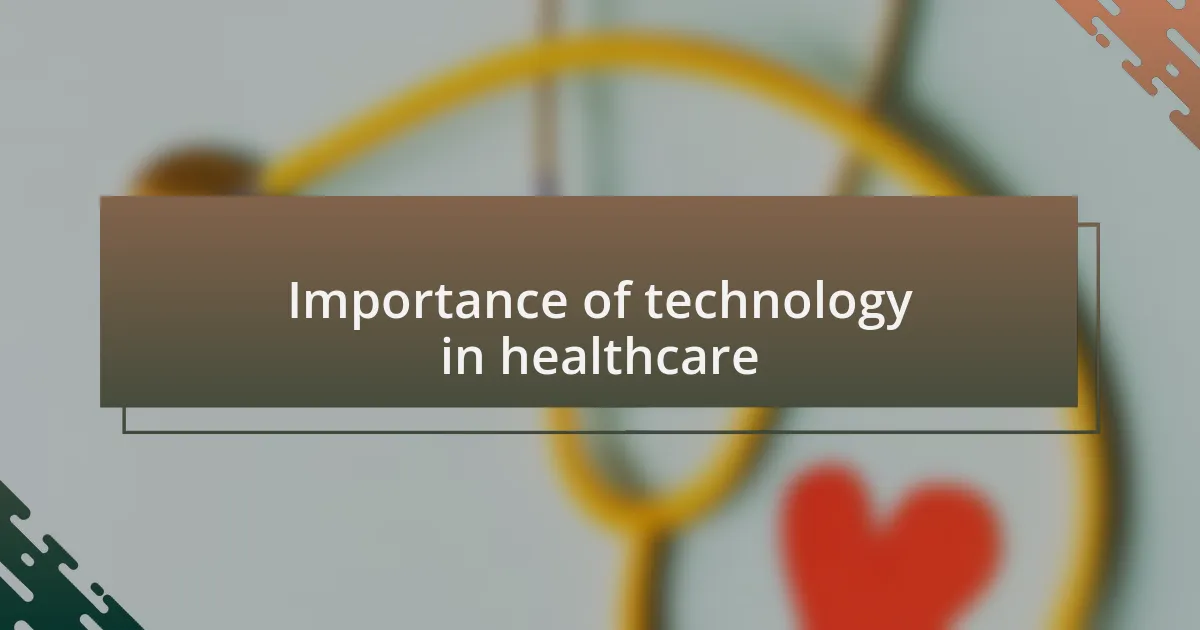
Importance of technology in healthcare
Advancements in technology have fundamentally transformed the landscape of healthcare, allowing for more efficient and accurate patient care. I remember the first time I used an electronic health record (EHR) system; it felt like a game-changer. No longer did I need to sift through piles of paperwork. Instead, I could access a patient’s history within seconds, which improved my ability to make timely decisions. Don’t we all want to provide the best care possible, streamlined by the power of technology?
Moreover, the growing use of artificial intelligence (AI) in diagnosing diseases has been a revelation. I’ll never forget the moment when an AI tool helped identify a subtle pattern in a patient’s lab results that I had overlooked. This not only made me realize the limits of human perception but also reinforced my belief in collaboration between human expertise and technological precision. Could it be that, in our quest to be the best healthcare providers, we need to embrace AI as a partner rather than a competitor?
In my experience, telemedicine has also emerged as a vital tool, especially during the recent pandemic. I vividly recall a patient with mobility issues who struggled to attend in-person visits. By utilizing telehealth, I could maintain regular contact, discuss treatment plans, and monitor their progress as if we were sitting in the same room. Isn’t it remarkable how technology can break down barriers and improve access to care? The potential for these advancements to elevate patient experiences is immense and deeply fulfilling.
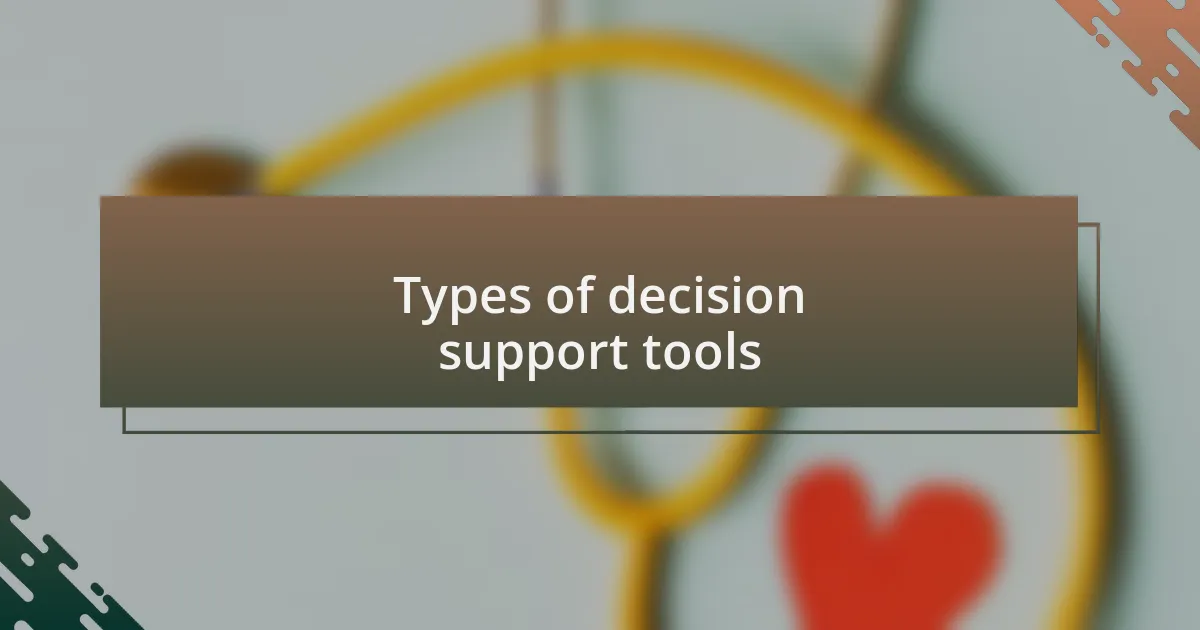
Types of decision support tools
Decision support tools in healthcare come in various forms, each serving a unique purpose. One of the most common types is clinical decision support systems (CDSS), which provide healthcare professionals with knowledge and patient-specific information to aid in decision-making. I recall using a CDSS during a particularly challenging case; the system flagged potential drug interactions that I hadn’t considered. It was a stark reminder of how much the right tool can enhance our clinical judgment and ultimately safeguard patient wellbeing.
Another notable category is predictive analytics tools. These are designed to analyze vast amounts of data to forecast potential health outcomes. I remember working with a predictive model that estimated which patients were at greater risk of readmission. The insights it provided allowed me to implement targeted interventions, which not only reduced readmission rates but also fostered a stronger relationship with my patients. Isn’t it incredible how data can guide our actions before issues arise?
Lastly, patient engagement tools play a crucial role in empowering individuals to be active participants in their own care. I’ve found that providing patients with access to their health data through portals significantly enhances their understanding and compliance with treatment plans. One patient expressed to me that having her lab results at her fingertips made her feel more in control of her health journey. How can we not appreciate the impact of engaging patients directly in their care? Each type of decision support tool enhances our ability to deliver personalized and effective healthcare.
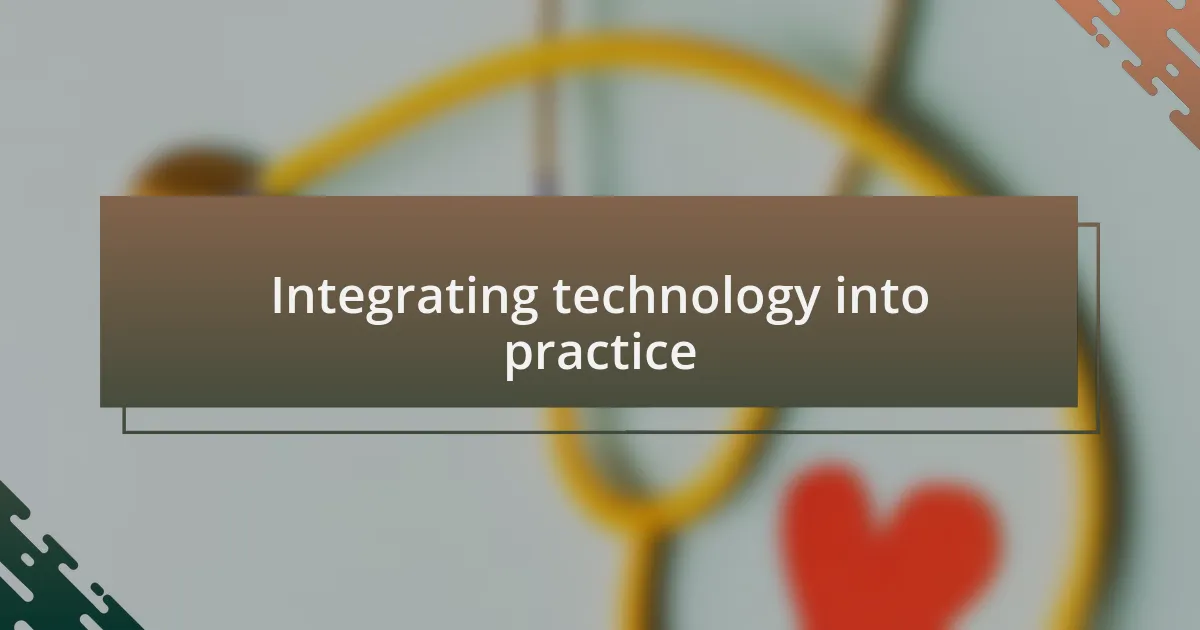
Integrating technology into practice
Integrating technology into practice has transformed how I approach patient care. In my experience, using telemedicine platforms has been a game changer, particularly during the pandemic. I vividly remember my first virtual consultation, where I could assess a patient’s condition from the comfort of their home. It struck me how technology not only broadened access, especially for those in rural areas, but also nurtured a sense of safety for patients during uncertain times.
One of the most significant aspects of tech integration is the creation of interoperable systems. When I started using electronic health records (EHRs) that seamlessly shared information across different platforms, it felt like a light bulb moment. An example that stands out is when I was able to coordinate care for a complex patient whose specialists were in separate locations. Having their information at my fingertips made collaborative decision-making much more efficient. Isn’t it powerful to think how interconnected systems can bring about a holistic view of a patient’s health?
Moreover, I find that training in these technologies is crucial for maximizing their potential. I organized a workshop for my colleagues to delve into effective ways of utilizing these decision support systems, and the enthusiasm was palpable. Hearing my peers share their successes, like improving medication adherence, highlighted how collective learning enhances our practice. It leaves me pondering: how can we create an ongoing culture of technology adoption that benefits both healthcare providers and patients alike?
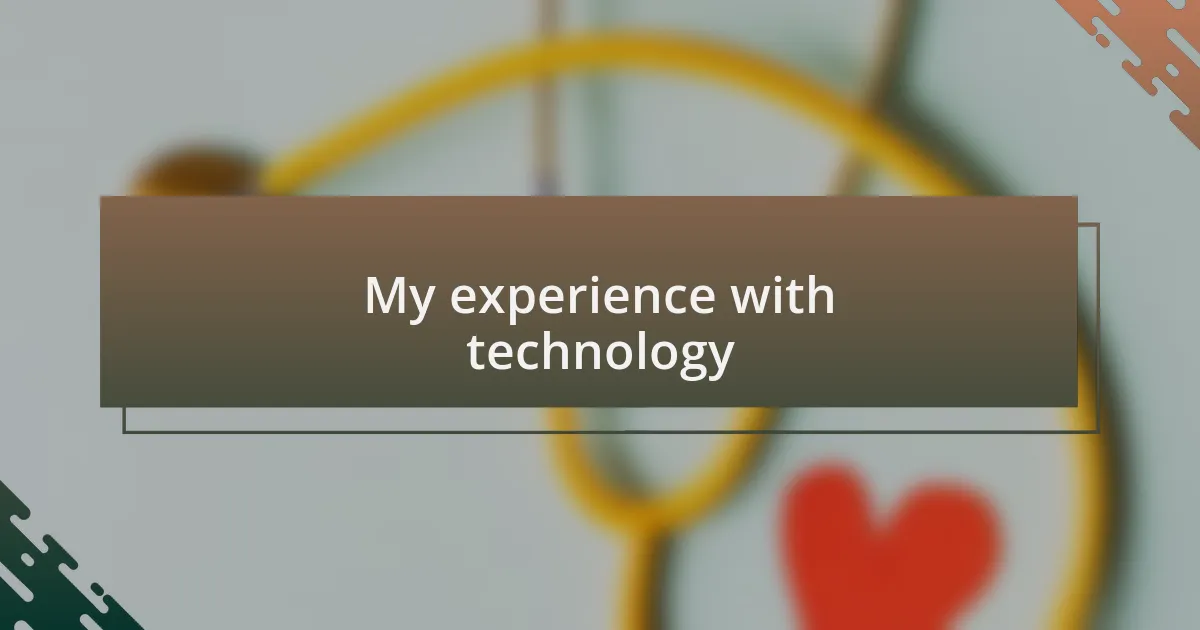
My experience with technology
When I first embraced technology in my medical practice, I was both excited and apprehensive. I remember struggling with the learning curve of a new software designed for decision support. There was a moment when I almost gave up, feeling overwhelmed by data entry and system navigation. But once I persevered, I discovered how much easier it made diagnosing complex conditions. Isn’t it fascinating how a single tool can shift your entire perspective on patient care?
Reflecting on my journey, I can’t help but share one instance where technology truly made a difference. While using a clinical decision support tool, I encountered a patient exhibiting unusual symptoms that didn’t quite fit a standard diagnosis. With just a few clicks, I accessed data and insights that illuminated a rare condition. The relief I felt when I found the right path forward was indescribable. It reinforced my belief in the power of technology to enhance our clinical instincts.
Over time, I’ve come to appreciate how technology consistently opens doors for collaboration. During a case conference, I recall connecting with specialists via a shared digital platform, each of us bringing our unique expertise to the table. The immediacy of having everyone in one virtual space, discussing one patient, was exhilarating. How can we harness this collaborative spirit further in our daily practices? It’s a question that drives my curiosity every day.
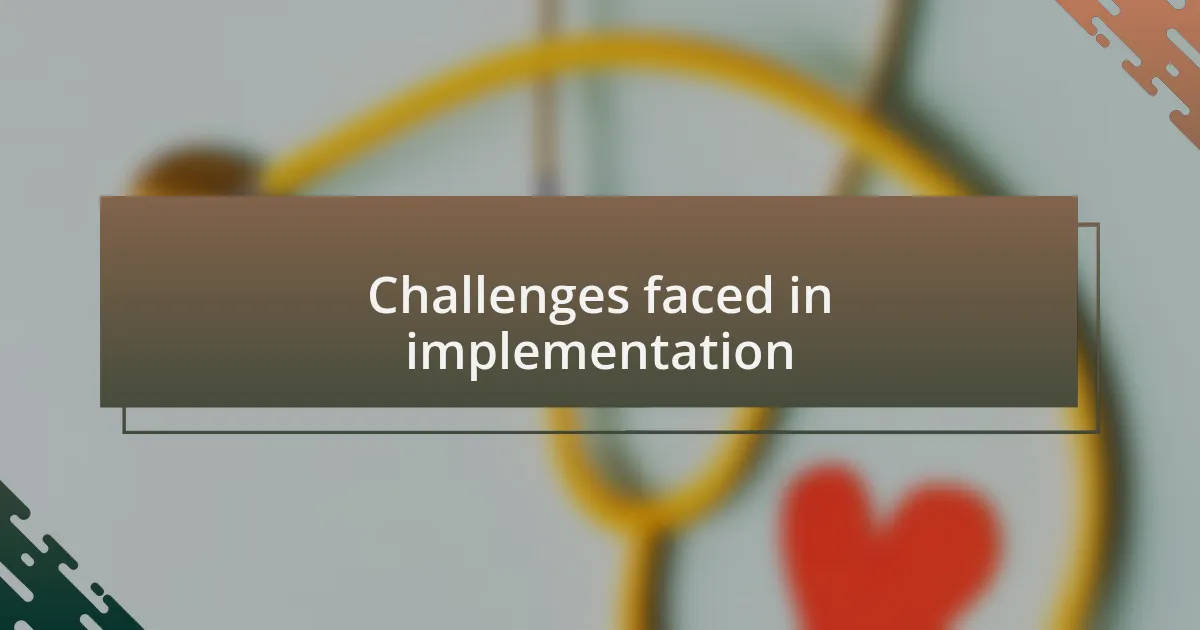
Challenges faced in implementation
Implementing technology in medical decision support isn’t always a smooth ride. I vividly remember a time when integrating a new decision support system led to significant resistance from my colleagues. Many were concerned about data security and the accuracy of the algorithm, which made it difficult to build the trust necessary for a successful rollout. Isn’t it curious how fear can often stand in the way of progress?
One unexpected challenge I faced was the inconsistency in data input among team members. During one crucial project, I discovered that inaccurate data entries skewed our results, leading to potentially harmful decisions. This experience highlighted the importance of standardized data collection methods. How can we ensure that everyone is on the same page and understands the critical role they play in patient care?
Additionally, time constraints remain a significant obstacle in the daily workflow. As busy healthcare providers, we often struggle to find moments to consistently engage with the technology required for effective decision support. I once had a particularly stressful week when I missed out on utilizing these tools due to back-to-back patient appointments. How can we create a culture that prioritizes learning and engagement with technology, even amidst our hectic schedules?
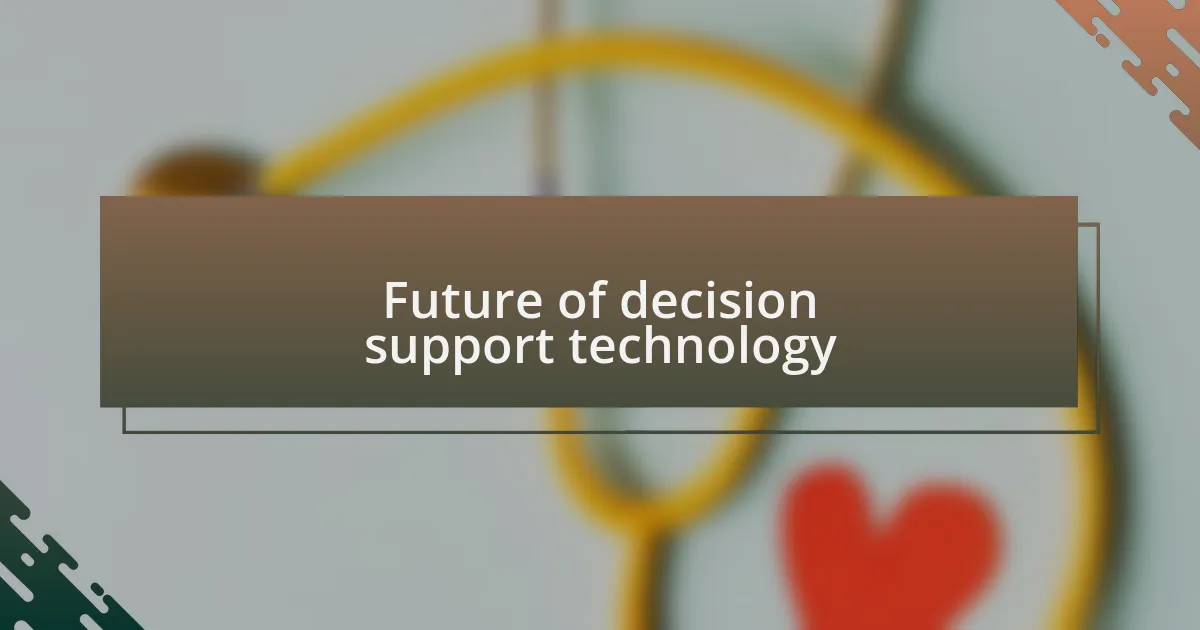
Future of decision support technology
As I look towards the future of decision support technology, I can’t help but feel excited about the potential of artificial intelligence and machine learning. I remember a conference where a speaker discussed how predictive algorithms could analyze vast datasets to provide insights in real time. Can you imagine a system that learns from each interaction and continuously improves its recommendations? That’s the kind of future I envision, where decision support systems not only assist but actually enhance clinical judgment.
Moreover, interoperability will play a crucial role in revolutionizing these technologies. In the past, I experienced the frustration of disparate systems that didn’t communicate effectively, which hindered our ability to make timely decisions. Isn’t it essential that different platforms work together seamlessly? By facilitating better data sharing and integration, future decision support tools can significantly reduce delays and enhance clinician efficiency.
Looking ahead, I believe that user-centered design will be a game-changer in medical decision support technology. I’ve noticed firsthand how intuitive interfaces can lead to quicker adoption among providers. Wouldn’t it be wonderful if future systems prioritize user experience, making our interactions with technology more fluid and less daunting? By focusing on the needs and workflows of healthcare providers, we can create more effective tools that enhance patient care rather than complicate it.